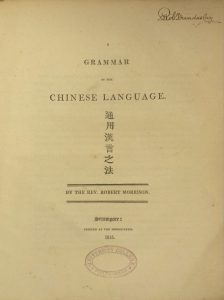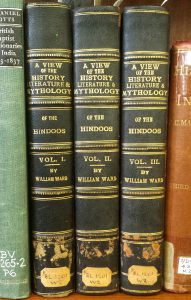August 14, 2017, by Kathryn Steenson
Bound for Serampore
Visitors to the Weston Gallery are often prompted to share their personal connections to an exhibition. It’s always wonderful to see people engaged and to know that it’s made an impact in a way that visitor statistics can’t capture. The story one recent visitor shared about the Threads of Empire exhibition was not just his family’s history, but a slice of local history linking the East Midlands to one of the oldest educational institutions in India, Serampore College, which celebrates its 200th anniversary next year.
Adjacent to a bus stop on Maid Marian Way in Nottingham is a green plaque reading “Upon this site formerly stood the Baptist Chapel in which William Carey (1761-1834) preached his memorable missionary sermon 30 May 1792”. Friar Lane Baptist Chapel was demolished in the 1950s, but in 1792 it was the scene of a ground-breaking sermon that inspired the formation of the Baptist Missionary Society. Carey went to India as a missionary shortly thereafter, the first of a group of missionaries who would become known as the ‘Serampore Trio’.
The city of Serampore in the Indian state of West Bengal was, at this time, a Danish colony. It may seem surprising that English missionaries were operating in Danish territory, but the East India Company had proved very hostile to their presence. The other members of the Trio, Joshua Marshman and William Ward, arrived in India in 1799. Ward was born in Derby in 1789 and was apprenticed to a printer named Drewry. He was later employed as editor and publisher for several newspapers, including the Derby Mercury, before becoming a Baptist preacher.
The Drewry family of printers to whom William Ward was apprenticed listed in Glover’s ‘History, gazetteer, and directory of the county of Derby’, 1829 (EMSC Der 1.D14 GLO)
E D Potts, in ‘British Baptist missionaries in India, 1793-1837: the history of Serampore and its missions‘ (Hallward Library BV3265.2.P6), suggests Ward was inspired to missionary work when Carey asked him to join him to ‘print the Scriptures’. Certainly, once in India, Ward set about establishing and running the Serampore Mission Press. A Bengali version of the Gospel of St Matthew was the first book printed, in 1800. As a missionary press, it printed translations of the Bible and Christian pamphlets in many different Indian languages, but also Indian literary works and grammar books, dictionaries and phrasebooks.

A grammar of the Chinese language by Robert Morrison, printed at Serampore at the Mission Press, 1815 (Special Collection PL1111.M6)
Included among the publications were their own newspapers – no doubt drawing on Ward’s experience in England – and scholarly research. The works were comprehensive, although coloured by the prejudices of the time.

A view of the history, literature, and mythology of the Hindoos by William Ward. This 1822 edition was arranged according to the order of the original work printed at Serampore (Special Collection BL1201.W2)
But in order to read the press’s prodigious output, the population had to be literate. Missionary schools were established for both boys and girls, with varying degrees of success, but by far the most enduring is Serampore College. It was given the power to award degrees in 1826 and today is affiliated with the University of Calcutta. The Trio founded it in 1818 with the dual purpose of providing higher education to students of every “caste, colour or country”, and a Christian theological college to train Indians for ministry.

Signature of Joshua Marshman, Master of Serampore College, on a letter to Lord William Bentinck, 1836 (Ref: Pw Jg 245)
William Ward returned to England and embarked on a fundraising tour whilst Carey and Marshman remained in India. Their efforts were widely known. In April 1836 Marshman wrote to Lord William Bentinck thanking him for ‘remembering Serampore College when you had left India forever’ and assuring him that His Lordship’s name would be ‘fondly cherished’ for his support. Bentinck had spent considerable time in India, first as Governor of Madras, then in 1827 as Governor of Bengal, before being appointed Governor General of India in 1833. His papers feature prominently in the exhibition, and any involvement with Serampore College isn’t a major part of his considerable legacy in India.

The Serampore missionaries, as described in ‘Abridgment of the History of India: from the earliest period to the present time’, John C Marshman (1893)
When Marshman composed his letter, he was the sole surviving member of the Trio, although he too would die just a year later. Ward died of cholera in 1823, less than two years after returning to India, and Carey died in 1834. Marshman’s son John Clark Marshman carried on their work for some time, and became a respected historian whose books were taught at the University of Calcutta. In 1860, Lady Denison and Lord Shaftesbury described him as the son of “the famous Marshman in India”.

The work of ‘the famous Marshman of India’ was still well-known in 1860, some 23 years after his death (Ref: Os C 1164)
Of the Trio, Carey’s is undoubtedly the most recognised name. Yet despite a distance of 5000 miles and 200 years, there is a tangible connection to the East Midlands: the press that produced the first New Testament in Bengali was operated by a printer from Derbyshire.
Threads of Empire: Rule and resistance in colonial India runs at Lakeside Arts until 20 August. Manuscripts & Special Collections holds a number of collections relating to India, including the Papers of the Lord William Bentinck, material relating to John S. Hoyland (1887-1957), Quaker and missionary in India, and the archives of various local Baptist churches (Friar Street Baptist Chapel records are held at Nottinghamshire Archives). To make an appointment to view our rare books and archives, please contact us.


On Friday 7th December 2018 Serampore College will celebrate its 200th Anniversary. A major exhibition is being held in the Main Hall of Serampore College with printed exhibits from their extensive collection of early printing in India.
This time the family of type cutters and casters who played a major part in the printing revolution that William Ward of Derby developed at Serampore, by creating the fonts for some 20 Indian languages, many for the first time, at least one with 700 characters, have been willing to lend the most extensive range ever of their font creation tools to the exhibition. The family still live in Serampore.
The exhibition has attracted crowds of Bengalis (this is an important part of their history) and visitors from all over India.
It is fitting too that William Ward has now been recognised as an equal member of the ‘Serampore Trio’ who founded the University, whereas before only Carey was celebrated as the founder.
2 x HD movies I have created in Derby are being played continuously at the exhibition.